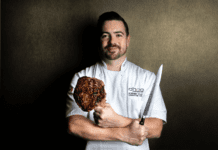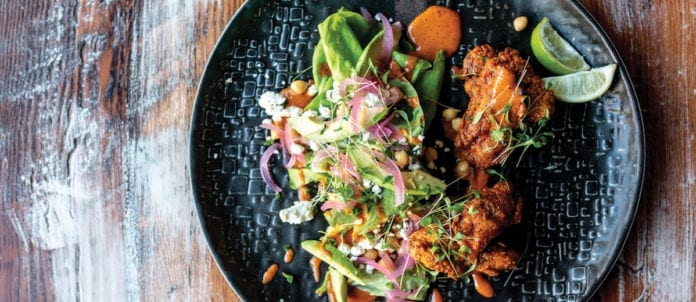Every chef knows it’s difficult to find a food that suits everyone’s taste. So what is it about turkey and chicken that makes them so innately likeable?
With recent Zion Marketing Research showing QSR growth is set to expand internationally at a rapid rate over the next few years, it doesn’t take a hawkeye to see the opportunities for poultry-focused QSR’s.
Canadian Mary Brown’s Chicken and Tators is taking full advantage and preparing to expand its brand throughout Asia, Africa and the Middle East. Chicken-focused QSRs are among the most inclusive types of fast food — chicken is consumed, in some form, by nearly every culture in the world, regardless of spiritual or cultural diet restrictions.
According to a recent consumer-trend report by Chicago-based Technomic, ethics also play a large role in chicken and turkey consumption among Canadians, with 49 per cent of regular chicken eaters claiming how the animals are treated and raised is important to them. QSRs and casual-dining restaurants specializing in chicken, such as KFC Canada and Swiss Chalet, have opened the dialogue on where their chicken originates, how the chickens are treated prior to processing and how they support Canadian chicken farmers.
Swiss Chalet, for example, supports the globally recognized “Five Freedoms” of animal welfare (as adopted by the Farm Animal Welfare Council) and works closely with the Chicken Farmers of Canada and the National Farm Animal Care Council to ensure the broiler chickens it uses in its rotisserie-style chicken dinners (starting from $10.99) have been raised according to these guidelines.
While demand for chicken continues to grow within Canadian foodservice, turkey — often seen as a health-forward protein option — declines outside of traditional turkey-eating times (think Christmas, Thanksgiving, Easter). While the ubiquitous turkey burger is a constant on many foodservice menus throughout the country, other cuts of turkey and preparations are few and far between.
Charlene MacNeil, chef/owner of Charlene’s Bayside Restaurant in Whycocomagh, N.S., serves up regular turkey specials that are a hit with both locals and the many visitors that come to Nova Scotia during peak tourist season. Known for their hospitality and inherent friendliness, many Maritime foodservice providers specialize in the no-fuss, home-style cooking the region is famous for.
“I have four turkeys in the oven as we speak,” laughs MacNeil. “We serve roasted turkey dinners and many other turkey menu items throughout the month.”
Charlene’s Restaurant posts a monthly menu calendar on Facebook to give its customers a heads-up on when their favourite meals will be on special. MacNeil has a large following of dedicated customers — some love her seafood chowder (made famous by the Food Network Canada show You Gotta Eat Here), while others simply crave the homecooked meals they grew up with — turkey dinners included.
“Turkey is a comfort food,” MacNeil continues. “It brings back good memories of celebratory meals. For the price you pay, you can serve a lot of customers with turkey.”
MacNeil is known locally for making homestyle meals with a special twist. She believes there’s a world of opportunity for different flavour combinations when working with turkey.
“It’s really versatile — you can do a lot with it,” she says. “You can spice it up in so many different ways. Make your dressing (stuffing) with apples and oatmeal or go really savoury. When you’ve had your meal, you can still get a lot out of a turkey carcass. Soup, pot pie — as a foodservice provider, you can make money with a turkey.”
Turkey dinners are a popular option for many on the East coast of Canada. In St. John’s, locals flock to their local chip shops — not for fish and chips, but for hot turkey pies with hefty sides of fries, dressing and gravy. Fabulous Foods is one of the most popular chip shops in the city, boasting an elaborate menu with a large chunk of hot and cold turkey offerings. Its hot-turkey sandwiches come in a range of styles and sizes (from $6.50) while its “Turkey Breaster” plates start at $4.85.
But it’s pies — boasting a savoury, flaky crust and gravy-laden filling — Fabulous Foods is famous for. Customers have the option of buying a whole pie ($5.50) or a quarter or half pie with fries (starting at $5.25).
In Toronto, Zane Caplansky has been serving chicken and turkey to hungry urbanites for years, including his take on the deli classic chicken soup with matzoh balls ($6) and his wildly popular turkey Rueben ($16) made with his own special-recipe sliced turkey.
“Turkey is one of those special-occasion birds that needs to find its way into everyday life,” Caplansky says. “It’s vastly unheralded as a protein.”
Though most consumers see turkey as a healthier protein option, its leanness has also led to it being considered an overly dry meat option. Finding the balance with the right turkey-based menu item can be difficult.
“My secret [in preparing turkey] is brining,” he explains. “By brining the bird, you give it juiciness; you give it flavour. All it takes is a day or two in a lovely bath. Give it some citrus, some pepper — those flavours then get sucked into the meat. When its cooked, it retains that flavour.”
Other not-so-secret Caplansky accompaniments to enliven any turkey sandwich are his mustards, which are available in four unique flavours and are available for order via Gordon Foodservice.
Since turkey and chicken are proteins that take flavour on so well, it’s no surprise McCormick Canada has plenty of recipes, saucy combinations and menu-item inspiration at its fingertips. According to its 2014 and 2017 flavour forecasts, turkey is increasingly being paired with sweeter sauces (honey or maple-syrup infused) and with Mexican or Mediterranean flavour profiles, while chicken is often being paired with peppercorns, cream cheese or tomato-based Indian flavour profiles.
McCormick Canada’s executive corporate chef, Juriaan Snellen, acknowledges that chicken remains a vastly more popular menu option than turkey, but that shouldn’t stop foodservice providers from including either protein on their menus.
“Almost all operators have chicken on their menu,” he says. “That said, some operators also offer turkey, as this is perceived to be the healthier option. As per Menu Monitor, 30 per cent of operators now have turkey on their menus and McCormick has a lot of flavour ideas for this dish.”
Its Devil’s Style Chicken, which features Mediterranean herbs, tangy white-wine vinegar and punchy Espelette pepper, is full of bold flavours that complement the chicken-thigh meat. Using ground turkey instead of traditional beef or lamb in a Kofta adds a layer of health and wellness to a much-loved menu item.
Shannon Crocker, registered dietitian and nutritional communications specialist, works with Mississauga, Ont.-based Turkey Farmers of Canada (TFC) regularly and has developed numerous recipes that are both nutritious and tasty enough to earn a valued spot on any menu.
“Turkey is for any day — not just holidays,” she says. “Supply is there; it’s based on consumer demand. Consumers are becoming more aware of turkey cuts and are looking for protein alternatives to swap out in their favourite recipes.”
Crocker says all foodservice providers have to do to make the menu option lighter and healthier is swap the traditional meat for turkey.
“In the summer, turkey pairs perfectly with veggies to make light, yet satisfying sandwiches,” she continues.
Sanagan’s Meat Locker in Toronto specializes in providing consumers, as well as chefs, ethically sourced, free-range chickens and turkeys from local farms. The hot counter at Sanagans features hot sandwiches using well-prepared cuts of his own locally sourced meats.
“I love a marinated bird, either chicken or turkey,” says Peter Sanagan. “An assertively seasoned marinade can add interesting flavour [to a bird]. That said, it’s not really necessary — if you have a good-quality, well-raised bird,you don’t want to hide the [natural] flavour too much.”
Written by Janine Kennedy

















